Deployment Phase – ERHMS
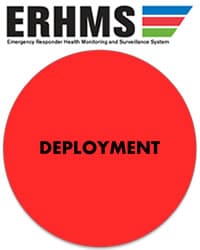
Deployment Phase
On-site Responder In-processing
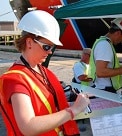
The processes of personnel identification, accountability, and tracking can be referred to as the response roster. Whenever the level of response is greater that what the first tier of local responders can handle, a roster should be used to log everyone who reports to the disaster site and is engaged in the response or remediation work. The logistics function of the incident command system (ICS) is responsible for collecting this information into a comprehensive rostering system. But accountability also includes parallel and linkable procedures that are conducted by the Planning function of the ICS (e.g., demobilization) and by the Command function of the ICS (Safety Officer). Site-specific training is required and must occur before responders enter a designated disaster control zone (see section 29 of the Code of Federal Regulations, standard number 1910.120). Strategies for implementing site-specific training should be pre-planned to the extent feasible, with consideration given to different training materials necessary to meet expected and unexpected health and safety hazards onsite.
A variety of personal protective equipment (PPE) may be needed by response workers and volunteers. For many workers, this equipment will be issued or dispensed to them during their site-specific training or as they arrive at the response scene and are place on the response roster. This central function or location for issuing PPE to responders serves as an opportunity for recording the amount, type, and condition of the PPE in the ERHMS system.
Tools & Resources
- ATSDR Rapid Response Registry
- ERHMS Fact Sheet: On-site Responder In-processing
- NIOSH Gulf Coast Oil Spill Initial Survey
Health Monitoring and Surveillance During Response Operation
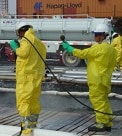
Health monitoring and surveillance are two different but complementary methods to protect the health and safety of emergency responders during an emergency operation. Monitoring refers to the ongoing and systematic collection, analysis, interpretation, and dissemination of data related to an individual emergency responder’s injury or illness status. This allows for the evaluation of occurrences and levels of exposures for an individual responder and the assessment of how that exposure is affecting them.
Surveillance refers to the ongoing and systematic collection, analysis, interpretation, and dissemination of illness and injury data related to an event’s emergency responder population. This allows for tracking emergency responder illness and injury trends within the defined population during response. A mechanism to allow tracking should be an integral part of the response to any event.
Tools & Resources
- ERHMS Fact Sheet: Health Monitoring and Surveillance During Response Operations
- National Response Team – Guidance for Managing Worker Fatigue During Disaster Operations
- NFPA 1584: Standard on the Rehabilitation Process for Members During Emergency Operations and Training Exercises
- OSHA Medical Screening and Surveillance
Integration of Exposure Assessment, Responder Activity Documentation, and Controls into ERHMS
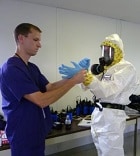
Response workers and volunteers may be exposed to many chemical, physical, and biological hazards in the course of their work. Obtaining accurate and valid worker exposure information is a crucial element in ensuring exposures are correctly characterized, risk is communicated appropriately, and sufficient information is available for making evidence-based decisions on how to protect the health and safety of response workers (e.g., work process changes, PPE, and work practice controls). The exposures addressed in the ERHMS document include biological, chemical, and physical hazards. Physiological stressors are also addressed and include sights and smells of death, exposure to the wounded, and risk of becoming a casualty. There are three risk management categories that safety officers, industrial hygienists, and other public health professionals learn from the assessment process:
- Acceptable exposures
- Unacceptable exposures
- Uncertain exposures (this requires further information gathering)
Responders’ activities and job tasks may change over the course of their deployment, so it is important to document them either through ICS 204 forms, job tickets, or whatever is being used. This information is then linked with exposure and health information to implement controls. Any controls that are implemented should be documented in the ERHMS system.
Tools & Resources
- AIHA Online Marketplace Store – Incident Safety and Health Management Handbook
- ERHMS Fact Sheet: Integration of Exposure Assessment, Responder Activity Documentation, and Controls into ERHMS
- FEMA Incident Command System (ICS) Form 204 Assignment Lists
- FEMA ICS Form 208 Site Safety and Control Plan
- NIOSH Health Hazard Evaluation of Deepwater Horizon Response Workers
- NIOSH Interim Information – Chemical Exposure Assessment Considerations for Use in Evaluating Deepwater Horizon Response Workers and Volunteers
- OHSA On-Shore Deepwater Horizon Personal Protective Equipment Matrix for Gulf Operations
- Recommendations for Biomonitoring of Emergency Responders: Focus on Occupational Health Investigations and Occupational Health Research
Communication of Exposure and Health Monitoring and Surveillance Data
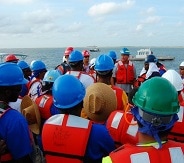
Communication is critical throughout the course of an emergency response. The scope of communication in an emergency response has many facets, including psychology (phase-dependent), messages (e.g., content, timing), audiences, and spokespersons. The collection of environmental exposure data and individual health and safety monitoring data, along with aggregate surveillance data, is relevant to protecting all responders involved in an event both short-term and long-term. However, this information must be communicated to workers, both internal and external to the organization, and inside and outside of the ICS structure. It is common for organizations to track and report data they are collecting within their own operational structures. But there is also a need for tracking and communicating more broadly. This is key to informing responders who need the information about pro-active steps they can take to protect themselves from hazardous exposures while attempting to protect the environment, identify and rescue survivors, or recover those who have died.
Tools & Resources
- COPS Interoperable Communications Technology Program: Communications in the Incident Command System
- DHS Privacy Act Guidance
- ERHMS Fact Sheet: Communications of Exposure and Health Monitoring and Surveillance Data During an Emergency Response
- ERHMS Emergency Responder Health Monitoring and Surveillance – Implementation Training
- FEMA – Use Of Social Media Tools At FEMA
- NIOSH Deepwater Horizon Data Use and Disclosure
- Quantitative Risk Communication: Explaining the Data. Video by Peter Sandman
- USCG Medical Manual, Chapter 12: Occupational Medical Surveillance and Evaluation Program
